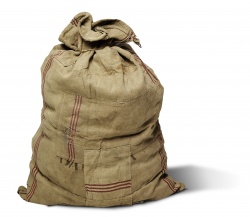Mouth Gagged, Hands Tied … - a gripping story
01. Mar. 2005

A typical example of the scarcity of goods during the occupation in 1940-45: A patched mail bag.
In the secure belief that war and occupation are something that goes on outside the boundaries of Denmark, we try to imagine the situations the ordinary Danes experienced during the occupation - and it is not merely a search for what happened then, but also an attempt to look inward and ask ourselves, "What would I have done?" "How would I have reacted?"
A New Form of Exhibition
For the last 6 months an exhibition team of the PTT Museum has been preparing a special exhibition about communication during the occupation "Mouth gagged, Hands tied ...".
On 9th April 2005 - precisely 65 years after the German occupation of Denmark - our work culminated with the opening of the exhibition which not only tells a new story, but tells it in a new and different way. Visitors do not meet a traditional exhibition with texts and wall sheets. This exhibition tells its story in a performance of light, sound, pictures and objects from back then... and not least some surprising effects.
A New Story
The narratives of the exhibition are about people, limitations, control, and communication; about censorship of letters, telegrams, press, and radio, about tapping and prohibitions, about secret and illegal communication, and about telephone companies that urged people to confine the number of calls. It is also a story of the many men and women who worked to ensure that letters were delivered and telephone calls connected.
During the years of occupation the employees of the Post & Telegraph Service and of the telephone companies were in a strange situation as public servants in companies that formed an important part of the Danish Government's collaboration with the German occupying power. Was it possible to stay true to the oath of office and one's own conscience - or were there situations when laws and rules had to be broken in the service of a higher cause?
With such questions in mind the exhibition team went on the hunt for the history of communication during the occupation. Many retired employees shared their memories with us in exciting and highly informative interviews; stories of people who were working during the occupation and with their own eyes saw a German soldier bleed to death, dined on potatoes that had been frozen during the winter, lit the gas generators, removed letters for the Gestapo, cycled through blackened-out streets on wretched tyres, or performed illegal work under German surveillance.
Many of the stories have been implemented in the overall frame story of the exhibition where the occupation, the policy of collaboration, the Resistance, the general strike, the time without the police, the liberation, and the juridical purge belong.
For the first time focus is on communication during the occupation and it is done in a new and surprising form of exhibition; an exciting experience which will hopefully arouse recognition with some and give insight to others.
The exhibition is on during the period 9th April till 23rd October 2005 in the Assembly Hall on the 4th floor of the museum.
In connection with the exhibition a booklet has been published which can be bought in the museum shop at the price of DKK 79.00. The booklet can also be ordered via the homepage of the museum. In case of mail order postage will be added.
This article may be copied or quoted with MuseumsPosten, Post & Tele Museum as source.
Comment this article
Only serious and factual comments will be published.